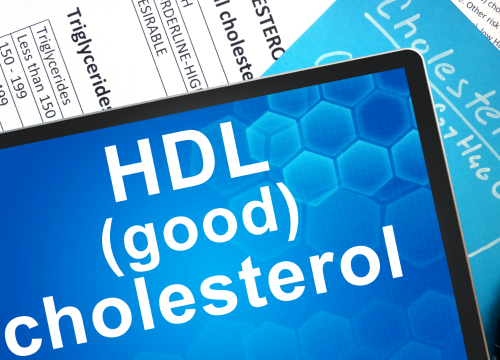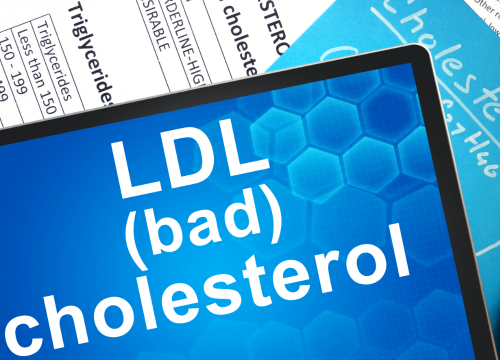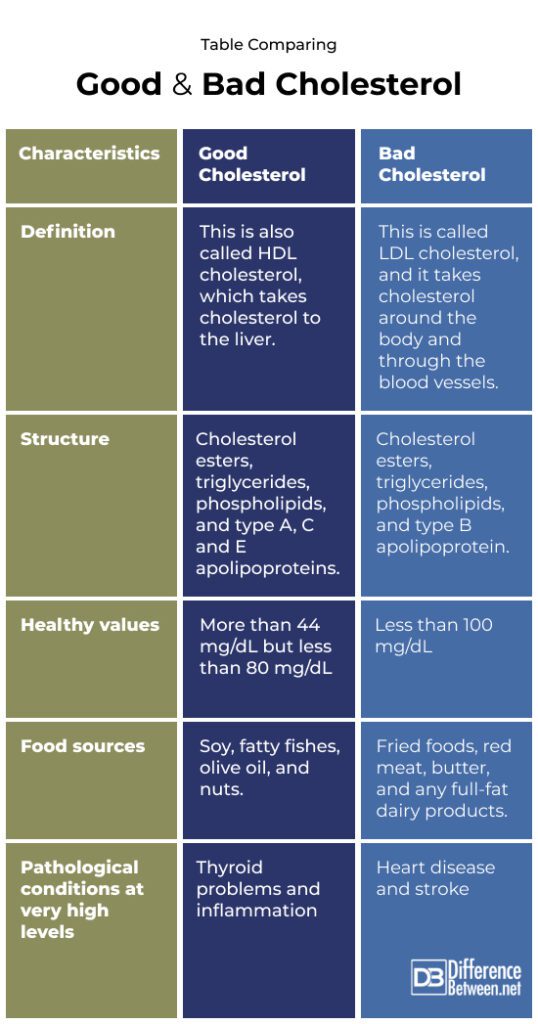Difference Between Good and Bad Cholesterol
Cholesterol is a fatty substance needed for building cell membranes and producing hormones. Different types, commonly known to us as “good” and “bad” cholesterol.
These types are classified based on the lipoproteins that transport cholesterol in the bloodstream.
Good Cholesterol (HDL – High-Density Lipoprotein): High-Density Lipoprotein (HDL) cholesterol is termed “good” cholesterol because it plays a role in cardiovascular health. HDL helps remove excess cholesterol from the blood vessels and transport it to the liver for removal. High levels of HDL are help with a lowering the risk of heart disease, making it a positive component of cholesterol profiles. Eating a healthy diet, exercising regularly, and avoiding smoking can help with getting higher HDL levels.
Bad Cholesterol (LDL – Low-Density Lipoprotein): Low-Density Lipoprotein (LDL) cholesterol is known to us as “bad” cholesterol because increased levels can lead to the accumulation of cholesterol in the arteries, making plaques that may restrict the blood flow. This can elevate the risk of cardiovascular problems, including heart attacks and strokes. Maintaining LDL levels is important for heart health. Lifestyle changes such as diet, exercise, and not using tobacco or smoking play significant roles in controlling LDL cholesterol. Some individuals may also need medication to manage LDL levels.
Therefore, the key difference between good and bad cholesterol is in their roles in the body and their impact on cardiovascular health. HDL cholesterol is beneficial as it helps get rid of excess cholesterol, while increased levels of LDL cholesterol can lead to the buildup of plaques in the arteries, leading to a risk to heart issues.

What is Good Cholesterol?
Definition:
Good cholesterol is also called high-density lipoprotein (HDL) because it transports cholesterol out of the blood and to the liver.
Structure:
The HDL molecule consists of triglycerides and cholesterol esters surrounded by phospholipids and three types of apolipoproteins, namely A, C, and type E.
Function:
The HDL conveys cholesterol to the liver and out of the bloodstream. It is believed that this is beneficial because it reduces the buildup of plaque in arteries thus helping prevent heart attacks and strokes.
Foods containing good cholesterol:
There are some foods that are high in HDL cholesterol. These include olive oil, nuts, avocado, and soy. Fatty fish is also a good source of this healthy cholesterol.
Problems when HDL is very high:
Although HDL is the better of the types of cholesterol, you can have too much. Excessive levels of HDL can cause problems such as thyroid issues and increased inflammation in the body. Inflammation has been linked to numerous diseases, so it is best to make sure your HDL is elevated but not above 80 mg/dL.

What is Bad Cholesterol?
Definition:
Bad cholesterol is the low-density lipoprotein (LDL), which carries cholesterol and takes it to organs that need it. However, cholesterol builds up in the arteries of the body if there is too much LDL.
Structure:
An LDL molecule consists of an outer layer of phospholipids that surrounds and encloses triglycerides and cholesterol esters. The outer layer also has apolipoprotein B present.
Function:
The LDL cholesterol picks up cholesterol and moves it to various organs and structures in the body that have receptors where these fats can attach. The LDL allows cholesterol to attach to the adrenal glands and muscles.
Foods containing bad cholesterol:
The foods known to have high levels of LDL cholesterol include red meats, full-fat dairy, butter, and fried foods.
Problems when LDL is very high:
If your LDL is above 100 mg/dL you have a much higher risk of developing clogged arteries, a hallmark of atherosclerosis. This is linked to an increased chance of blocked arteries which can lead to strokes and heart attacks.
Difference Between Good and Bad Cholesterol
Definition
Good cholesterol is HDL cholesterol, which takes cholesterol to the liver. Bad cholesterol is LDL cholesterol, which takes cholesterol around the body and through the blood vessels.
Structure
Cholesterol esters, triglycerides, phospholipids, and type A, E, and C apolipoproteins make up good cholesterol. Cholesterol esters, triglycerides, phospholipids, and type B apolipoprotein make up the bad cholesterol.
Healthy values
The healthy values of HDL are more than 44 mg/dL but less than 80 mg/dL. Bad cholesterol needs to be kept below 100 mg/dL.
Food sources
You can find HDL in nuts, soy, and fatty fish. You can find LDL in full-fat dairy, butter, and red meat.
Pathological conditions at very high levels
Excessive levels of good cholesterol can cause issues with the thyroid and inflammation. Excessive levels of the bad cholesterol can cause heart disease and stroke.
Table comparing Good and Bad Cholesterol

Summary of Good Vs. Bad Cholesterol
- Good and bad cholesterol both occur in the human body.
- Good cholesterol really refers to HDL, which helps move cholesterol out of the blood vessels.
- The bad cholesterol is the LDL, which has a tendency to deposit cholesterol in the blood vessels.
- It is important to make sure you eat foods that are not high in the bad LDL, but rather have high HDL levels.
FAQ
Which is more harmful LDL or HDL?
The LDL is more harmful to the body than HDL.
What is a normal HDL and LDL level?
The HDL should be more than about 40 or 44 mg/dL and LDL should be less than 100 mg/dL.
Is HDL or LDL more important?
Having a higher value of HDL is most important as this helps remove fats from the blood.
How can I reduce my LDL?
A change in diet, and sometimes medication, can help you to lower your blood LDL level.
How high is too high for HDL?
Having HDL that is higher than 80mg/dL is considered too high.
What is the ideal LDL level?
It would be ideal if you have an LDL of below 100 mg/dL.
What are 3 best foods for lowering cholesterol?
The three foods that help to lower cholesterol are nuts, oats, and beans.
What are the 5 signs of high cholesterol?
You are unlikely to notice you have high cholesterol unless you have a blood test or show problems such as peripheral artery disease, coronary artery disease, or have a heart attack or stroke. You may have symptoms like chest pain, nausea, slurred speech, numbness on one side of your body, and shortness of breath.
Are eggs bad for high cholesterol?
Eating one egg a day is unlikely to cause high cholesterol levels, but researchers suggest that more than one egg a day may elevate cholesterol in certain people. This may be related to genetics and other factors though.
What are the six super foods that lower cholesterol?
Foods that decrease cholesterol include legumes, oats, nuts, berries, fruits, and fatty fish.
Are bananas good for cholesterol?
Bananas are helpful in reducing cholesterol because they have a lot of potassium and fiber.
What foods flush cholesterol?
Eating healthy foods like nuts and beans can help the body remove cholesterol.
What is the best drink to lower cholesterol?
Green tea is one of the best beverages to drink to reduce cholesterol levels in the body.
Does peanut butter help cholesterol?
It depends what the peanut butter mix contains; if there are no hydrogenated fats added, then it is healthy since peanut butter contains high amounts of unsaturated fats.
Can I drink coffee if I have high cholesterol?
You should not drink too much coffee (more than 5 cups a day) because it contains chemicals called diterpenes, which depresses the body’s capacity to lower cholesterol.
- Difference Between Rumination and Regurgitation - June 13, 2024
- Difference Between Pyelectasis and Hydronephrosis - June 4, 2024
- Difference Between Cellulitis and Erysipelas - June 1, 2024
Search DifferenceBetween.net :
2 Comments
Leave a Response
References :
[0]Cleveland Clinic. “Lipoproteins”. Cleveland Clinic, 2023, https://my.clevelandclinic.org/health/articles/23229-lipoprotein
[1]Orlova, Elena V., et al. "Three-dimensional structure of low density lipoproteins by electron cryomicroscopy." Proceedings of the National Academy of Sciences 96.15 (1999): 8420-8425.
[2]Pirahanchi, Yasaman, Hadeer Sinawe, and Manjari Dimri. "Biochemistry, LDL Cholesterol." StatPearls, 2018, https://pubmed.ncbi.nlm.nih.gov/30137845/
[3]Image credit: https://www.canva.com/photos/MADCKyi6QNA-ldl-bad-cholesterol/
[4]Image credit: https://www.canva.com/photos/MADCKzon5rc-hdl-good-cholesterol/

Sorry to completely disagree with you. But cholesterol is just cholesterol and lipoproteins are proteins, the two are not the same. The lipoproteins transport the cholesterol to and from cells to the liver, but that’s all they do. The cholesterol is produced in the liver. There is no good and bad cholesterol, since there is only one cholesterol.
I’m getting pretty sick and tired of this pseudo medical farce being played on the public about cholesterol being good or bad, all in the name of selling pharmaceutical drugs. Cholesterol is only found in one form in the body, it never changes. HDL and LPL simply transport the cholesterol, they too cannot be good or bad. Can they be oxidized? Yes, but so can red blood cells.
No, cholesterol is cholesterol. Look at the names, high density lipoprotein, low density lipoprotein. These molecules are proteins! They are different carrier molecules for cholesterol but there is only cholesterol. It is as silly as claiming there are two types of oxygen because there is oxygenated and deoxygentated hemoglobin.
Cholesterol is an essential component of every cell membrane and important for myraid physiologic functions. When Dr. Uffe Ravnskov, MD PhD looked at the medical literature he found something quite surprising had been documented there. On average people with higher cholesterol live longer. Then again the statin cholesterol lowering drug class alone is a 30 billion dollar a year industry while the latest is they are saying too many children have high cholesterol cynically looking to expand the industry even further.
http://healthjournalclub.blogspot.com/